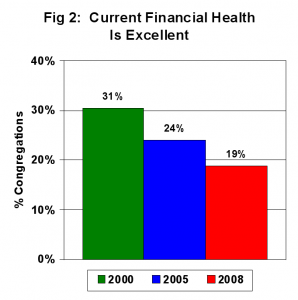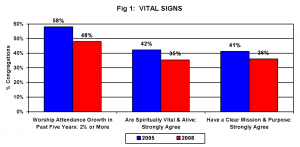While some sociologists have been talking about the growing None population in the U.S. for a while now (see this report for an example), you know things have to be getting bad when researchers employed by the religions themselves are starting to worry about the health and vitality of religions in the U.S. The latest Faith Communities Today (FACT) survey is out and things don’t look good. Financial health is down
Average age is up:
Vitality is down:
Things aren’t looking good for religion.



Hm.
The only thing that I can agree with as far as looking bad for religion is financials (the top graph).
If I interpret the second graph correctly, then 76% of evangelical congregations and 64% of RC/ortho congregations consist of less than 26% seniors. The only drastically aging congregations are traditional Protestant.
In the last graph, still almost half of congregations are growing by 2% or more. But growth is temporary. What about steady numbers?
Additionally, the last two comparisons in the last graph are meaningless because they’re only “Strongly Agree.” Why don’t “Agree” or “Somewhat Agree” responses count? What are the responses? The report doesn’t say.
The problem with this is that sociologists, anthropologists and others have been predicting the demise of religion for decades, but I don’t really see it going anywhere any time soon.
And in reality, this only bothers me to the extent that it seems like more and more adamantly religious people are becoming more extreme in their beliefs. Which is not as bothersome as it might be, considering that among many of the people who I know who I would assume are extreme in their religion based on how they label their religious membership, most are much more reasonable in their beliefs than conventional wisdom would lead me to believe.
Not talking Mormons here, by the way, but those of other Christian denominations and other traditions. Not at all…the thing I find most frightening are some of the inactive Mormons I know who still go out of their way to go on and on and on about how wonderful The Church(TM) is.
Maybe I just know different people than the ones who are included in these kinds of studies.
Hi John,
Yep, the really bad news is the financials – they are getting pretty bad.
As far as the aging component, the ages are up in all of them, but are the worst for the mainline Protestants. Why that is a concern: very few congregations with a heavy elderly population are growing.
The last figure is better described in the report. But the point is – religious vitality is down in every single religion. That’s an across the board decline.
So, to say this isn’t bad news for religions is missing the point: people aren’t as excited about religion and they aren’t giving as much. Additionally, the people attending are getting older, though that is hitting the mainline hardest at the moment. In short, religion isn’t doing all that well in the U.S. and those who are paid by the religions are admitting it. This last part is the most interesting: it says that the religions can’t deny declines anymore.
Hi Elaine,
I wouldn’t say that religion is going to disappear any time soon. But the current trend is one of decline. What that means in the long run, I don’t know. But the short-term outlook isn’t positive.
As far as the implication, you’re probably right. Religious fundamentalism is a response to modernity and liberalization of religion (as well as secularization). Some people clearly liberalize in their views, but others become more militant. Mark Juergensmeyer illustrates that there has been an increase in religion-inspired terrorism in the last 40 years precisely because of this.
Let’s just hope the militants continue to be marginalized.
Up from what? The chart only shows current numbers. Additionally, it only bodes ill for Mainline Protestant. The other numbers aren’t unusual, and the Evangelical Protestant numbers suggest young or middle-aged congregations for the most part.
As for vitality, I disagree that the report explains anything there. Again, what about the “agree” numbers? This report seems to focus on superlative reactions like “strongly agree” or “financial health is excellent.”
Additionally, figures for different years are inconsistent or omitted. Why do some charts show 2000, 2005, and 2008 while others show only 2005 and 2008 (or bafflingly, 2000 and 2008, with a blank legend entry where 2005 would otherwise fit)?
Why isn’t there a longitudinal comparison for one of the most important data points in this study, the age of congregations?
Then perhaps I’m missing your point, because your title is “things are bad for religion?”. I disagree with that notion (or rather my answer to the question is negative).
Also, I disagree that things are worsening for religion as a whole. Evengelical Protestantism seems to be doing just fine, even by the report (and that’s a huge chunk of the religious in the US). Or maybe there is a decline. Since 2000. What about since the 90’s or the 80’s? Religion enjoyed a resurgence under the Bush administration. Maybe we’re just seeing the bubble deflate a little.
This study strikes me as a marketing tool to sell common sense to churches. Look at the end of the study. It basically says, “outreach, recruitment, and vision will help you grow.” Well, duh. And the website takes you to other pamphlets that you can buy in bulk. It screams marketing BS.
John,
First, keep in mind that the title of the post is “things are bad for religion?” with a question mark. My take is that they are. But it was a question. Ergo, you are welcome to disagree.
Second, I agree that the report isn’t the greatest. But I’m not sure why you are being soo critical of it. The FACT survey isn’t conducted every year. It was first conducted in 2000. So, they don’t have data before 2000 that is comparable. They also don’t ask every question every time they do conduct it (surveys are expensive). So, cut them some slack.
It would be nice if they reported the “agree”, “neutral”, “disagree”, and “strongly disagree” responses. But they didn’t. However, what they did do is interpret their findings for us,
So unless you only believe charts and graphs, I’m inclined to think that the author, David Roozen, isn’t lying about vitality and financial health – they are both down (and that is during the Bush administration).
As for age, you may have a point. I pulled average age for frequently attending (more than 1x per month) Protestants from the GSS for 4 periods – 1970s, 1980s, 1990s, and 2000s for the three groups labeled in the GSS – fundamentalists, moderates, and liberals. Here’s what you get:
How it looks to me is that moderates and liberals are basically in-line with the mean age for the entire population (which has, of course, gone up), but liberal Christians have gone up substantially more than the average. So, age may not be increasing all that much for evangelicals (they would fall into the moderate and fundamentalist groups).
“Soo”? The reason that I’m being critical of it is that it’s being used to draw conclusions. Any such document deserves a critical eye. So no, I’m not going to cut any slack. But these are good points about the survey questions.
That much is glaringly obvious. Whenever conclusions are presented they should be backed up.
I don’t. I’m skeptical of all charts and graphs when they’re used as a primary source of information.
When did I say “lie”? I said “BS”. BS can come from bad interpretation and omission of data as well, and I’m not saying it has to be malicious. He may well be completely convinced of his conclusions, and probably is. If he was completely convinced of them before he started, that’s a big problem, especially when conducting a survey.
Look at this new Gallup Poll. It also shows religion declining, and covers a longer time period.
Karen Armstrong pointed out that contemporary religions tend to be a bout traditionalism. If that is true then it is little wonder that the adherents are getting older and cannot attract enough young people.
Yep, and I trust Gallup. 🙂 And note that “other” and Catholic are relatively steady.
@Hellmut: I think that’s partially true. But there’s another factor to it I think. Catholicism is very traditional, but isn’t in the same kind of decline that liberal/moderate protestantism is. I would guess that’s because of the “cultural”-Catholic phenomenon.
Protestantism, OTOH, is a lot more fluid. Protestants tend to pick a church that fits their lifestyle and is near where they live. If you stop practicing, you stop being a protestant.